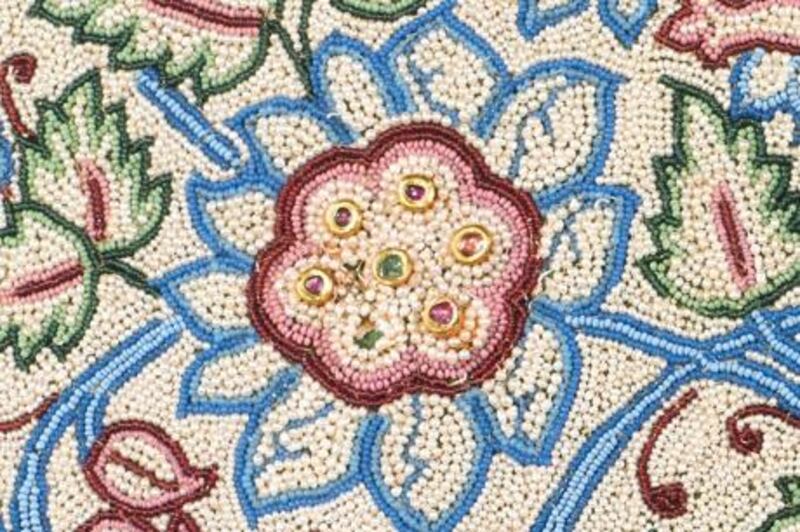NEW YORK // An embroidered masterpiece bearing more than 500,000 pearls that were plucked from the Arabian Gulf in the 19th century being auctioned in Manhattan tomorrow offers a potent reminder of the region's historic diving industry.
The so-called Pearl Canopy of Baroda, emblazoned with an array of Gulf pearls, English coloured glass beads, diamonds, rubies, emeralds and sapphires set in gold, is expected to fetch up to US$5 million (Dh18m) when it is put under auction by Sotheby's on Friday.
The textile treasure was commissioned by the Maharaja of Baroda, Khande Rao Gaekwad, in about 1865 and was reputedly originally destined to adorn the tomb of the Prophet Mohammed in Medina, but it stayed with the family after the maharaja's death.
It was shown before crowds in Delhi in 1902-03 and was then hidden from public view for more than a century before its appearance in last year's exhibition at the Victoria and Albert Museum, London, called Maharaja: The Splendour of India's Royal Courts.
The canopy serves as a "reminder of the flourishing pearl-trade between the Indian subcontinent and the Arabian Gulf", said Mary Jo Otsea, a carpet expert for Sotheby's. "The pearl trade dominated the Gulf's economy and reached its golden age in the mid-19th century.
"Some of the highest quality pearls were discovered at this time and were then sold in Basra, the centre of the trade, mostly to Indian merchants. Due to the excellence and abundance of the pieces exported from Basra, pearls from the Gulf region were known as 'Basra pearls' throughout the world."
Russell Shor, an analyst for the Gemological Institute of America, said the switch to cultured pearls throughout the early 20th century, together with windfall profits from a booming oil industry, heralded the collapse of the Gulf's natural pearl market.
The industry is witnessing a minor renaissance, with between 10 and 20 kilos of natural pearls currently extracted from the Gulf shores each year. "Naturally-occurring pearls sell at a substantial premium over cultured pearls because people favour the real thing and value their rarity," Mr Shor said.
Khaled al Sayegh, chairman of the Pearl Revival Committee, counted some 200 pearl diving sites in Abu Dhabi out of 412 across the entire Gulf at a pearl conference in the capital last November. He lauded an "unprecedented lustre for this jewel on the global scale".
The silk canopy was crafted for the Maharaja in an ensemble of five pieces and patterned in Indian and Persian styles. The only other surviving item, the Pearl Carpet of Baroda, fetched $5.5 million at auction in Doha in March 2009.
Masterpiece made from 500,000 Gulf pearls expected to fetch $5m
The magnificent Pearl Canopy of Baroda, adorned with Gulf pearls, diamonds, emeralds, rubies and sapphires and reputedly originally destined to adorn the tomb of the Prophet Mohammed in Medina, is up for auction in Manhattan tomorrow.

Editor's picks
More from the national






